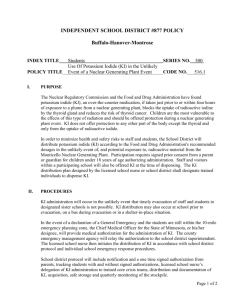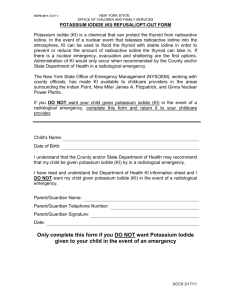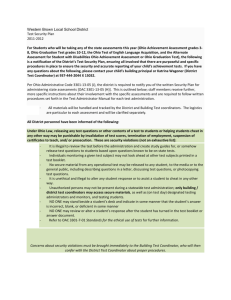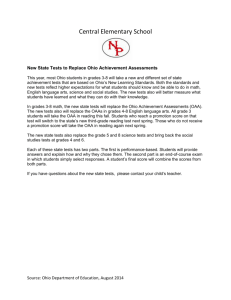use of potassium iodide for the 10
advertisement
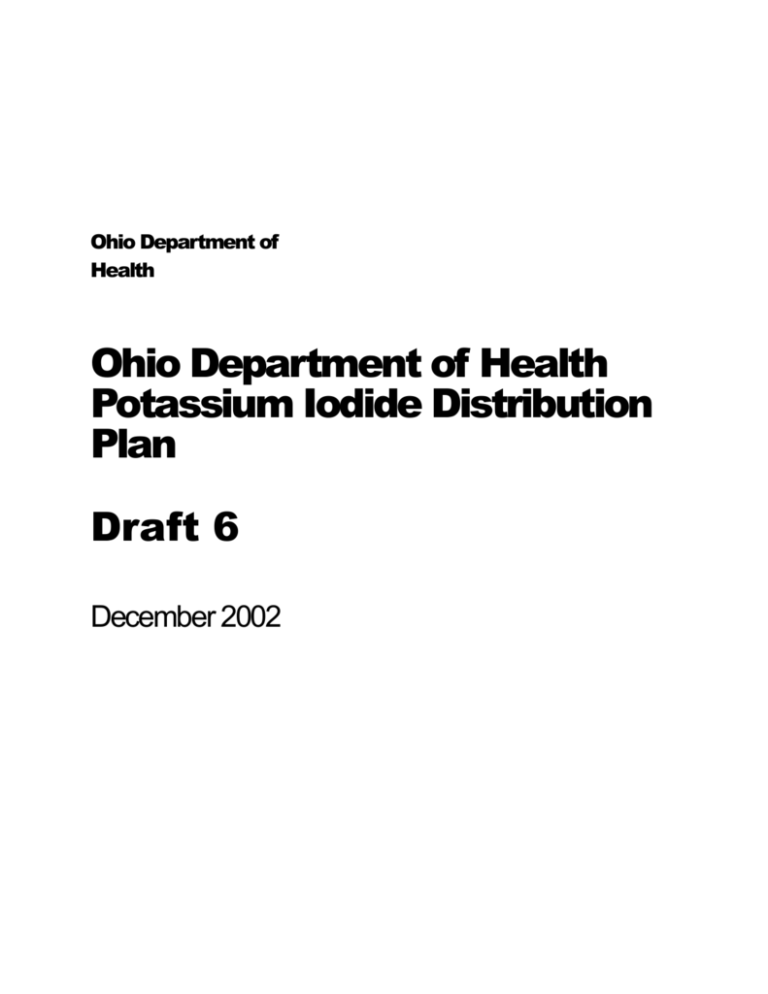
Ohio Department of Health Ohio Department of Health Potassium Iodide Distribution Plan Draft 6 December 2002 Ohio Department of Health Bureau of Radiation Protection Potassium Iodide Distribution Plan December 2002 DRAFT 6 Page 2 Bureau of Radiation Protection Recommended Ohio Plan for Distribution of Potassium Iodide (KI) Background The US Nuclear Regulatory Commission notified states with nuclear power plants in December 2001 that they were making Potassium Iodide available to states to provide to citizens in the event of a serious accident at a nuclear power plant. The NRC referenced an earlier rule that the Commission had adopted regarding states considering the use of Potassium Iodide as a supplemental measure to other established emergency actions in the areas surrounding nuclear power plants. The Ohio Department of Health conducted a series of three public meetings in February and March of this year to receive public input regarding whether Ohio should apply to the Nuclear Regulatory Commission for Potassium Iodide. As a result of those meetings, the Ohio Department of Health developed a policy statement regarding the use of Potassium Iodide. The policy was approved by the Director of Health and concurred with by Governor Taft. The policy provides the following: KI is to be pre-distributed to residents in the ten-mile emergency-planning zone. KI is to be pre-distributed to schools in the ten-mile emergency-planning zone. KI is to be stockpiled for most transient residents. Emergency plans should be modified to recommend the evacuation of school children at the declaration of site area emergency when conditions at the nuclear power plant warrant this type of action. State and local emergency plans are to be modified to incorporate measures and procedures to provide for the use of KI as a supplemental measure to evacuation. On May 22, 2002, the Ohio Department of Health applied to the NRC for Potassium Iodide and received the requested medications in June. The Department moved to the implementation aspect of the operation and established a Potassium Iodide Planning Committee composed of representatives of local health districts, local emergency management agencies, local school districts, the Ohio Pharmacist Association, the Ohio Emergency Management Agency, and the Ohio Department of Health. The Committee has met twice. The Ohio Department of Health also determined that $45,000 would be made available to four local health districts to assist them in the distribution of KI in the respective emergency planning zones surrounding the Beaver Valley Nuclear Plant, the Davis Besse Nuclear Plant, and the Perry Nuclear Plant. The department has negotiated contracts with these four local health districts. The planning and distribution of KI to more than 130,000 residents is complex and multi-faceted. The plan needs to address each of the elements of the KI policy approved by the Director of the Department of Health. Given the complexity of this issue, the department believes that there needs to be several parts to the plan. The department of health recommended approach to the implementation of the KI plan is to use phases. Although a phased approached is recommended, the department believes that aspects of each phase should be going on concurrently so that the all elements of the plan for the use of KI are completed by March 31, 2003. The department has also developed the plan so that the public distribution aspects of the plan related to schools and the public is going on nearly concurrently. Ohio Department of Health Bureau of Radiation Protection Potassium Iodide Distribution Plan December 2002 DRAFT 6 Page 3 KI Plan Elements Phase One--Interim Measures--completion date October 31, 2002 Over ninety percent of the KI is shipped by the Ohio Department of Health for subsequent distribution by the Columbiana County Health Department, East Liverpool City Health Department, Lake County Health Department, and the Ottawa County Health Department by October 31, 2002. The remaining ten percent will be sent prior to the distribution by the local health departments. Local health departments will decide on the location for storage of KI that is stored for distribution and/or stockpiling. The KI will be prepared in individual dose containers and labeled appropriately. Interim procedures are used that provide for the distribution of KI to evacuation centers if an emergency occurs prior to distribution to residents. The Ohio Emergency Management Agency submits the interim procedures to FEMA. Phase Two-Public Distribution-completion date February 28, 2003 Implement the distribution of KI to residents in each of the ten-mile emergency planning zones using a combination of clinics and pharmacies in the respective communities. The elements of the distribution are specified in the contracts with the local health departments. The elements are as follows: Coordinate and insure that all persons living within the designated ten-mile emergency planning zone (EPZ) of each nuclear power plant are provided with opportunity to receive two Potassium Iodide (KI) tablets during the period of January 17, 2003, through February 1, 2003, (the KI campaign distribution period) for use during a significant emergency at each nuclear power plant. Contact pharmacies provided by ODH to enlist their cooperation in the dispensing of a packet of two KI tablets to residents in the ten-mile emergency-planning zone surrounding the each nuclear power plant. Provide each pharmacy with the information they are required to collect and/or review from/with each participant in the KI distribution campaign. This information would include items such as identification verification and completed coupons. The pharmacy portion of the KI distribution campaign will be from January 25, 2003, through February 1, 2003. Local health districts and pharmacies may mutually agree to extend the pharmacy portion of the campaign. Conduct three to five clinics during the January 17, 2003, through January 24, 2003, portion of the KI campaign distribution period. At least one of the clinics shall be conducted at other than normal business hours. The purpose of the clinics is to demonstrate the dispensing of medications to large numbers of persons in the health district using the concepts and planning of the National Pharmaceutical Stockpile (NPS), and specifically to residents of the each health district who reside in the ten-mile (EPZ) of each nuclear power plant. Provide public information to designated news media regarding the campaign to distribute KI to residents of the ten-mile EPZ of the nuclear power plant. ODH will provide examples. Provide a list of pharmacies with the contact name, address, and telephone number that will participate in the distribution of KI to ODH by December 16, 2002. Provide KI to each participating pharmacy. Each dose will be in a plastic container holding two KI tablets in blister packs and a package insert for the KI. The health district will provide additional doses from the ODH supply to pharmacies that require additional KI during the distribution campaign. The remaining doses will be Ohio Department of Health Bureau of Radiation Protection Potassium Iodide Distribution Plan December 2002 DRAFT 6 Page 4 shipped directly to the health district by ODH for use with transient populations and school populations. Develop, print and send a letter including a coupon to each resident of the ten-mile EPZ using the mailing list or other postal information provided by each nuclear power plant. The letter contains information regarding the availability of KI, the locations where the KI can be obtained, and a coupon that the resident uses to obtain KI from a participating pharmacy or health district clinic. Examples of the information and the coupons will be provided by ODH. Contact each participating pharmacy after the completion of the distribution campaign to collect KI that was not used. Collect coupons that were received during the distribution campaign by the pharmacy and remit the coupons to the ODH by February 28, 2003. Coupons are remitted to ODH to simulate the NPS aspect of medication distribution regarding who received a medication. Provide information to recipients of KI to destroy KI at the end of its useful shelf life. The current shelf life for KI is five years and current stores of KI should be removed from use in 2007. ODH will plan to operate an information line with a toll-free line (phone number is 866 936-4636) during the hours of 7:45 a.m. through 4:30 p.m., Monday through Friday, between January 6th to January 31st. The purpose of the line will be to answer general questions regarding KI and provide information regarding clinic and/or pharmacy locations that are available in a particular EPZ area. Phase Three-School Distribution-completion date February 28, 2003. The school-planning phase includes the following assumptions: 1. Schools will be encouraged to evacuate at site area emergency if plant conditions warrant such action so there is little chance that children will be exposed to radioactive iodine. 2. KI is pre-distributed to schools in packets of baggies, each having an FDA-approved label, containing two 130 mg tablets. 3. School children may need to receive KI before evacuation, during transit to a reception center, or after relocation to a reception center. School personnel may need to administer KI at any of these times. 4. Parents shall decide to authorize or not to authorize their children to receive KI. The recommended elements of the school phase are as follows: The Director of ODH sends a letter to the Ohio Department of Education advising them of the state policy regarding the distribution of KI to the general public including school children. ODH will provide guidance and background information regarding KI for use by local health districts in working with school officials. Each local health district and local emergency planning agency contacts the superintendent of each school district that has one or more schools in the ten-mile EPZ for each nuclear power plant to secure the support of applicable school district(s) to ensure that each school in the respective EPZ will evacuate students during an emergency and provide KI to their students in accordance with emergency response plans (deleted the parenthetical). The health district will provide sufficient KI to schools such that each student from an evacuating school can receive one tablet of KI from an emergency worker if need be. Schools are expected to provide and receive back parental authorization or denial for students to receive KI in the case of an emergency as determined by local emergency management and health Ohio Department of Health Bureau of Radiation Protection Potassium Iodide Distribution Plan December 2002 DRAFT 6 Page 5 authorities and distribute KI to students in their respective schools. This parental authorization will need to be renewed annually in September and upon any student coming into the district. The local health district will provide each school in the EPZ with background information regarding the use of KI. Each school that is in the EPZ of one the nuclear power plants is expected to store sufficient KI for distribution to their respective students if directed by ODH. Each school needs to determine a proper location for storing the KI. The storage location needs to be secure and environmentally controlled. A possible location may well be the school nursing office. The KI should be stored in "go-kits". A "go-kit" consists of packets of KI (The kits may optionally include water and paper cups) that are sufficient for the number of children that will be sent on a particular bus or that are in a particular classroom. For example if a school bus or classroom, as the case may be, has 42 children, the go-kit would include the baggies containing the KI tablets, 50 six ounce paper cups, and sufficient water to provide each child with 4 – 6 fluid ounces of water to take the KI tablet. The "go-kit" goes on the bus with the children. In addition each go-kit should include a copy of the list of children who have and have not been authorized to receive KI as well as a medication administration documentation form. Schools may wish to consider the use of applesauce to assist children with swallowing difficulties take the KI. Crushing or dissolving of KI at the time of administration is permissible. The packaging of the "go-kits" should match the method that the school employs to determine how children are assigned to a particular bus. If an evacuation is in progress and ODH recommends the administration of KI, designated school personnel should distribute the go-kits as required for administration by designated personnel who have been prepared for the administration of medications. Information is available from ODH through the local health department. Schools should utilize their school nursing personnel or others who are knowledgeable about procedures for medication administration as they develop their policies and procedures on KI administration. Training is not required but is believed to be a best practice that can mitigate any concerns regarding the use and administration of KI. If the KI is recommended to be administered prior to evacuation of the school, then the children will receive the KI from each "go-kit". Each school should participate in training and exercises to insure that school personnel are familiar with requirements for evacuation of school children and the possible need to administer KI to children. KI distribution should be incorporated into overall school and school building emergency response plans. A record of any KI that is administered to children should be maintained for submission to the local health district upon request. School staff can receive KI as part of the pre-distribution of KI to transient populations if the school board opts to provide for this Phase Four-Transient populations-completion date March 31, 2003 This phase of the plan primarily provides for stockpiling KI at reception centers or other appropriate locations for use if an evacuation occurs. Most transient populations will be provided KI through stockpiling the KI at reception centers or other post accident distribution centers specified by the county emergency plan. No pre-distribution is required for most transient population groups or transient organizations. For the purposes of this plan transient organizations and populations are those that are located in the ten-mile EPZ that are not part of the residential population or the school population. Ohio Department of Health Bureau of Radiation Protection Potassium Iodide Distribution Plan December 2002 DRAFT 6 Page 6 If a recommendation was provided by ODH for persons to take KI, then individuals arriving at reception centers will be given KI upon arrival. If members of the transient population such as businesses in the ten-mile EPZ wish to receive and distribute KI in the event of an emergency, the local health district will provide the employers with packets of KI for distribution to employees. The employer must agree to take responsibility for storage of the KI in a secure, environmentally controlled location and agree to distribute KI upon the direction from emergency broadcast messages. The local health district may wish to enter into similar agreements with other transient-type locations such as child day care centers or migrant labor camps or other facilities located in the ten mile EPZ as well. Priority should be given to locations that are likely to have significant child populations. Any transient agreement that involves the administration of KI to minors, needs to have received consent from parents prior to providing KI to these organizations. The local health district should assure that the transient organization has the capacity to properly manage the storage and distribution of KI prior to entering into any agreement to pre-distribute KI to that transient organization. Local health districts are to maintain records regarding the amounts of KI provide for pre-distribution to transient populations. Phase Five-Revision and finalization of state and local emergency response plans- completion date March 31, 2003. This phase of the KI plan assures that the requirements of the Federal Emergency Management Agency are met for the distribution of KI to the general public as a supplemental measure to evacuation. The plans and procedures need to: Identify the person with the legal authority to make the decision to recommend the ingestion of KI by the general public. In Ohio that person is the Director of Health. Assign responsibility for implementing the KI decision. In Ohio the state and local health departments share that responsibility. Specify the decision criteria for administration of KI. The KI policy provides for administration of KI when the projected dose would deliver a 5 rem committed dose equivalent to the child thyroid to individuals in the ten-mile EPZ. Specify procedure to determine that the quantity of pills needed. The procedure that was used included using census data and population estimates from local emergency management plans. Local officials provided information for transient populations. Specify the procedure to ensure that the supply of KI is sufficient for the EPZ population including transient population groups. The KI plan provides for notifying the residential population using the same mailing lists that the power plants use. The plan calls for pre-distributing one dose of KI for each child for use by school officials and the establishment of KI "go-kits" in schools. Identify Off site Response Organizations procedures to request store, monitor and safeguard dispense and track who received the KI, and the disposal of KI stocks upon expiration. The KI distribution plan to the residential population and the schools includes these provisions. Describe the method to alert and notify the general public of the decision to recommend they ingest KI. Based on weather and plant conditions and information provided by the plants to state and local officials, recommended protective action recommendations will be prepared by state dose assessment personnel. The recommendations will be concurred by state and local officials. The basis for protective action and the ingestion of KI will be a declaration of a General Emergency condition for Ohio Department of Health Bureau of Radiation Protection Potassium Iodide Distribution Plan December 2002 DRAFT 6 Page 7 the first 24-hours. The Ohio Emergency Plan will be revised to allow for flexibility. Thus, automatic recommending of KI ingestion may be exempted for some General Emergency conditions that do not have the potential for iodine release (e.g., security conditions). For the second 24-hour period, the recommendation for the ingestion of KI will be based on a projected dose of 5 rem to the child thyroid. The protective actions will be based upon the appropriate sectors surrounding each respective plant. Pre-scripted Emergency Alert System (EAS) messages and Special News Broadcasts will be prepared and submitted to FEMA along with copies additional educational information and brochures that will be used for the distribution of KI to the public. The recommendation for evacuation and administration of KI is per specific emergency planning zone sub areas in accordance with the Ohio radiological emergency plan. Evacuation remains the primary protective method for individuals with the administration of KI being a supplemental protective measure.
